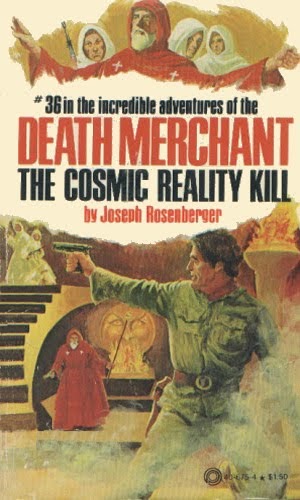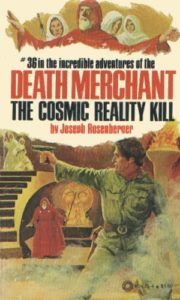Book Review: Death Merchant #36: The Cosmic Reality Kill by Joseph Rosenberger
Richard Camellion is an assassin for hire, usually working for the CIA at $100,000 per mission. A master of disguise and killing, the “Death Merchant” is one of the top assassins in the world. But even a man like Camellion (not his birth name) has friends. One of them is Everett Padden, a “deprogrammer” who helps people escape dangerous cults.
When Padden turns up beaten to death in Fort Worth, Texas, the obvious suspects are the Cosmic Reality Church and its leader, the Reverend Hannibal Frimm. With a heady mix of brainwashing, hypernationalism, and gnosticism, Frimm has created a fast-growing cult that on the surface seems law-abiding, but whose enemies suffer terrible misfortune. The police can prove nothing, so it’s time for the Death Merchant to take a hand!
The Death Merchant series of violent men’s adventure books ran from 1971 to 1988, with this volume coming out in 1979. As with many paperback thrillers of the time, it tied into the fear of dangerous cults that had become prominent in the 1970s, and particularly drew on the mass suicide of Jim Jones’ supporters in Guyana in 1978.
As might be expected, Camellion is cold-blooded about killing, and has no remorse about the slaughter of anyone who is waving a weapon in his general direction. While admittedly at least some of the “Frimmies” are culpable for murder or other crimes, many of them are just brainwashed dupes defending their homes against an intruder.
After his plan to subtly infiltrate the Fort Worth cult camp disguised as an alien invader fails and he has to kill multiple Frimmies to escape, Camellion decides to try heading to their main quarters in Colorado Springs.
Unfortunately, the Cosmic Reality Church has a competent but amoral detective on its payroll. He hasn’t learned who Richard Camellion really is, but does know Camellion’s one of Padden’s known associates, and has often been murder-adjacent. The cult’s enforcers are less competent, and their attempt to “make it look like an accident” wind up in a multiple-car chase and crash sequence that would have looked great in a Seventies action film. More Frimmies are shot.
This results in Camellion coming to the attention of the local sheriff, who is sure the hobby rancher is up to something, and investigates for the rest of the book in a subplot that leads nowhere.
Camellion calls in a couple of markers from the CIA, netting a couple of “off-duty” agents (actually working for the CIA’s highly illegal Domestic Operations branch.) Camellion disguises himself as a senior citizen, while the agents play his son and wife. Camellion gripes to himself about having to shell out for his own RV. The plan is to look like ordinary tourists getting a tour of the Cosmic Reality campus, then subtly infiltrate to assassinate Frimm.
This all works fine until Camellion actually tries to get into position to do the job, at which point the “old man” is made, and Camellion must shoot his way out of this compound too. Perhaps realizing that subtlety is not his forte, Camellion decides mass murder is the best solution, and comes up with a plan involving attack helicopters, special forces, and a massive dose of LSD.
We do get some characterization for the head Frimmies; Frimm himself was at one point a sharp operator who probably started the cult as a cash cow, but has long since guzzled his own Kool-Aid and is seriously over the edge. Frimm’s main supporters range from true believers through people who only now realize how crazy he’s become to the guy who’s just in it for the cash.
The lesser Frimmies get a name, age and perhaps a funny last thought before the Death Merchant puts a bullet through them.
As was often the case in these men’s adventure books, the main character tends to be a mouthpiece for the author’s own views. Camellion lectures his assistants (and the reader) on the evils of cults, spouting chunks of information the author gathered on a trip to the library (nowadays it would all be from Wikipedia.) Junior CIA agent Russell Linders quotes heavily from the Principia Discordia without attribution (but with an author tip of the hat.)
There’s no actual sex in the book, but Camellion does lustfully stare at his attractive “daughter-in-law” and order her to fry him steaks as her part of the masquerade.
Also notable is the men’s adventure focus on brand name products and loving description of guns and gadgets. You too could order many of these items from the ads in the back of Soldier of Fortune magazine.
Despite the title, there is very little of the paranormal here; in one scene it’s revealed that Camellion can see his own aura, or at least thinks he can. Apparently in another volume he encounters actual aliens; it’s not made clear here if the mask he wears at the beginning is a tribute to them.
This is considered one of the better entries in the Death Merchant series; if you like men’s adventure of the 1970s, you may be able to find it at a garage sale.


